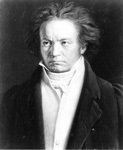1598 ~ The first patent to print songbooks was issued on this day to Thomas Morley, a composer of madrigal songs.
![]() 1902 ~ Donald Jay Grout, American musicologist
1902 ~ Donald Jay Grout, American musicologist
A History of Western Music. An older version of this book is available for loan in the O’Connor Music Studio
More information about Grout
• 1927 ~ Joaquín Gutiérrez Heras, Mexican composer
• 1928 ~ Glen Gray’s orchestra recorded Under a Blanket of Blue, with Kenny Sargeant on vocals.
• 1930 ~ Tommy Collins (Leonard Sipes), Singer, songwriter
• 1938 ~ Ben E. King (Benjamin Earl Nelson), Singer, songwriter
• 1946 ~ Helen Shapiro, Singer, actress
• 1968 ~ The Beatles rode the nearly seven-minute-long Hey Jude to the top of the charts for a nine week-run starting this day. Talk about your microgroove recording! Copies of this Apple release were shipped by the dozen to radio stations because the platters wore out after just a few plays.
• 1984 ~ Saluting his 34 years in television, Bob “If There’s an Honor I’ll Be There” Hope showed outtakes of his years in television on (where else?) NBC. When he began in television’s infancy, back in 1950, Hope said he got into the new medium “…because the contract was so delicious, I couldn’t turn it down.”
• 1991 ~ Miles Davis III passed away
• 1994 ~ “Cats” 5,000th Broadway performance (joined A Chorus Line & Oh! Calcutta!)
• 2010 ~ Dolores Wilson, American opera singer
• 2015 ~ Frankie Ford, American rock vocalist (Sea Cruise), died at the age of 76


